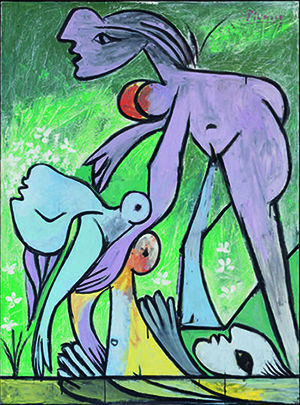The Une Anatomie drawings may, therefore, depict an autobiographical reality reflecting Marie-Thérèse’s condition during the period of her illness. As to the duration of her illness Richardson and Brigitte Baer provide us with two different scenarios. Richardson claims she was fully recovered by mid-January 1933 and Baer stated that, “She was more or less convalescent during the first months of 1933 and so less often with him, which allowed him to take stock of the situation” (Baer 1997: 33). Richardson's account places the creation of the Une Anatomie drawings after her recovery, whilst Bear’s gives them a near contemporary relevance. Either way its not surprising that Picasso may have reacted to Marie-Thérèse's life threatening illness through some form of artistic intervention. On two previous occasions he was traumatised by the death of females that he dearly loved. His beloved sister Conchita was seven when she died of diphtheria and Eva Gouel, his mistress, died at the age of thirty after contracting tuberculosis. Both of these traumatic events, along with Olga’s recurring health issues, no doubt caused Picasso to develop a fear of illness, both in himself and the women in his life.
Le Sauvetage (The Rescue)
Picasso’s immediate reaction to Marie-Thérèse’s near death encounter and its consequences was to produce paintings, drawings and etchings depicting numerous scenarios in which she is dramatically saved from drowning. The Rescue and Bathers Playing Ball, 1932, even conflates the theme of bathers playing ball on a beach with that of a seaside rescue from drowning and all the female figures appear modelled on Marie-Thérèse (Fig.18). Many of the paintings also show the impact of the accident via graphic depictions of severe weight and hair loss (Figs.19).
Richardson and Widmaier Picasso both associate Picasso’s Rescue paintings with votive practices. In Volume 4 of his magnum opus, “Picasso: His Life and Work”, (1933-43), which was posthumously published in late 2021, Richardson points out that the 1932 incident was not the only time Marie-Thérèse came close to drowning, but that in 1928 she also nearly drowned whilst rescuing a fellow teenager who was staying at the same summer camp for young girls that Picasso had placed her in, whilst he and his family stayed elsewhere in Dinard (Richardson 2021: 8). Richardson then went on to say, “As we shall see, the
 19
19 Fig.18 Picasso. The Rescue and Bathers Playing Ball, painting, 22-12-1932
Fig.19 Picasso. The Rescue, painting, December 1932. Foundation Beyeler, Reihan/Basle, Switzerland